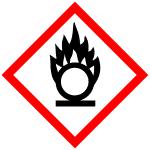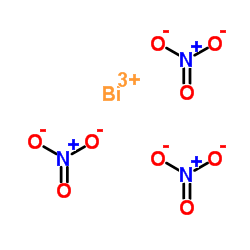1304-85-4
| Name | Bismuth hydroxide nitrate oxide |
|---|---|
| Synonyms |
Bismuth(III) subnitrate
Bismuth(3+) trinitrate Bismuth subnitrate bismuth nitrate Bismuth(III) nitrate EINECS 233-792-3 MFCD00064844 |
| Description | Bismuth subnitrate (Bismuth(III) oxynitrate) is a bismuth(III) compound that bears significant medical uses (e.g., as an antidiarrheic agent). Bismuth subnitrate is a simple, readily available and effective catalyst for the Markovnikov-type hydration of terminal acetylenes[1]. |
|---|---|
| Related Catalog | |
| References |
| Density | 4.928 |
|---|---|
| Melting Point | 260°C |
| Molecular Formula | BiN3O9 |
| Molecular Weight | 394.995 |
| Exact Mass | 394.943848 |
| PSA | 206.64000 |
| LogP | 0.85230 |
| Stability | Stability Strong oxidizer - contact with combustible material may lead to fire. Incompatible with reducing agents, organic materials. |
CHEMICAL IDENTIFICATION
HEALTH HAZARD DATAACUTE TOXICITY DATA
|
| Symbol |


GHS03, GHS07 |
|---|---|
| Signal Word | Danger |
| Hazard Statements | H272-H315-H319-H335 |
| Precautionary Statements | P210-P220-P221-P305 + P351 + P338-P370 + P378 |
| Hazard Codes | O,Xi |
| Risk Phrases | 8-36/37/38 |
| Safety Phrases | S17-S26-S36/37/39 |
| RIDADR | UN 1477 5.1/PG 2 |
| WGK Germany | 3 |
| RTECS | EB2977000 |
| Packaging Group | II |
| Hazard Class | 5.1 |


